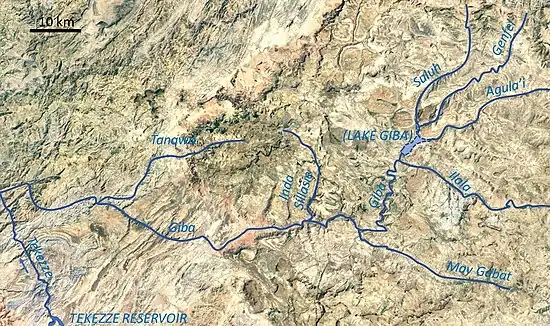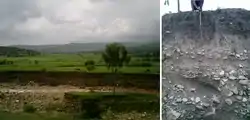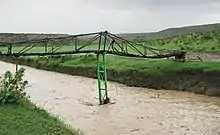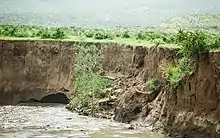Agula'i River
Agula’i is a river of northern Ethiopia. Rising in the mountains of Atsbi Wenberta (2676 metres above sea level), it flows southwestward to Giba River which empties finally in the Tekezé River.[2] Future Lake Giba will occupy the plain where Sulluh, Genfel and Agula’i Rivers meet.

| Agula'i River | |
|---|---|
 The Agula’i River upstream from Agula’i | |
 Agula’i River in Tigray Region | |
| Etymology | After the homonymous town |
| Location | |
| Country | Ethiopia |
| Region | Tigray Region |
| Districts (woreda) | Kilte Awula’ilo |
| Physical characteristics | |
| Source | |
| • location | Hayki Mesal in Atsbi Wenberta |
| • elevation | 2,159 m (7,083 ft) |
| Mouth | Giba River |
• location | Worgesha in Emni Ankelalu |
• coordinates | 13.626°N 39.404°E |
• elevation | 1,750 m (5,740 ft) |
| Length | 50 km (31 mi) |
| Basin size | 692 km2 (267 sq mi) |
| Width | |
| • average | 25 m (82 ft) |
| Discharge | |
| • location | Near outlet[1] |
| • maximum | 520 m3/s (18,000 cu ft/s) |
| Basin features | |
| River system | Permanent river |
| Landmarks | Agula’i town |
| Waterbodies | Future Lake Giba |
| Bridges | Agula’i town, Birki |
| Topography | Mountains and deep gorges |
Hydrography
It is a confined river, locally meandering in its narrow alluvial plain, with a slope gradient of 8 metres per kilometre. With its tributaries, the river has cut a deep gorge.[3]
Hydrology
Hydrological characteristics
The runoff footprint or annual total runoff volume is 115 million m³. Peak discharges up to 520 m³ per second occur in the second part of the rainy season (month of August) when there are strong rains and the soils are saturated with water in many places. The percentage of total rainfall that directly leaves the catchment as storm runoff (also called runoff coefficient) is 12%. As limestone is present in 47% of the catchment this runoff coefficient is less than that of adjacent rivers.[1]


The total amount of sediment that is transported by this river amounts to 1.95 million tonnes per year. Median sediment concentration in the river water is 3.78 grammes per litre, but may go up to 97 g/L. The highest sediment concentrations occur at the beginning of the rainy season, when loose soil and dust is washed away by overland flow and ends up in the river, and towards the end when river bank erosion is frequent.[4] As such water contains many nutrients (locally it is called “aygi”), farmers estimate that it strengthens their cattle, which they will bring to the river.[3] All in all, average sediment yield is 3784 tonnes per km2 and per year. All measurements were done at a purposively installed station near the mouth of the river, in the years 2005–2007.[4]
Flash floods
Runoff mostly occurs in the form of high runoff discharge events that occur in a very short period (called flash floods). These are related to the steep topography, often little vegetation cover and intense convective rainfall. The peaks of such flash floods have often a 50 to 100 times larger discharge than the preceding baseflow. These flash floods mostly occur during the evening or night, because the convective rain showers occur in the afternoon.[3]
Changes over time
Evidence given by Italian aerial photographs of the catchment, taken in the 1930s show that 51% of the catchment was covered with woody vegetation (against 45% in 2014). This vegetation could slow down runoff and the runoff coefficient was smaller (8% in 1935 against 12% in 2014). As a consequence, discharges in the river were less and the river was narrower than today.[5] Up to the 1980s, there was strong pressure on the environment, and much vegetation disappeared.[6] This river had its greatest discharges and width in that period. The magnitude of floods in this river has however been decreased in recent years due to interventions in the catchment. On steep slopes, exclosures have been established; the dense vegetation largely contributes to enhanced infiltration, less flooding and better baseflow.[7] Physical conservation structures such as stone bunds[8][9] and check dams also intercept runoff.[10][11]
Irrigated agriculture
Besides springs and reservoirs, irrigation is strongly dependent on the river's baseflow. Such irrigated agriculture is important in meeting the demands for food security and poverty reduction.[3] Irrigated lands are established in the narrow alluvial plains all along the river and pump irrigation is used.
Transhumance towards the river gorge
The valley bottoms in the lower gorge of this river have been identified as a transhumance destination zone. Transhumance takes place in the summer rainy season, when the lands near the villages are occupied by crops. Young shepherds will take the village cattle down to the gorge and overnight in small caves. The gorges are particularly attractive as a transhumance destination zone, because there is water and good growth of semi-natural vegetation.[12]
Boulders and pebbles in the river bed
Boulders and pebbles encountered in the river bed can originate from any location higher up in the catchment. In the uppermost stretches of the river, only rock fragments of the upper lithological units will be present in the river bed, whereas more downstream one may find a more comprehensive mix of all lithologies crossed by the river. From upstream to downstream, the following lithological units occur in the catchment.[13]
- Amba Aradam Formation
- Agula Shale
- Antalo Limestone
- Mekelle Dolerite
- Quaternary freshwater tufa[14]
Trekking along the river
Trekking routes have been established in nearby Dogu’a Tembien.[15] The tracks are not marked on the ground but can be followed using downloaded .GPX files.[16] Trek 24 passes along the confluence of Agula’i and Giba River. In the rainy season, flash floods may occur and it is advised not to follow the river bed. Frequently, it is then also impossible to wade across the river.[17]
See also
References
- Amanuel Zenebe, and colleagues (2013). "Spatial and temporal variability of river flows in the degraded semi-arid tropical mountains of northern Ethiopia". Zeitschrift für Geomorphologie. 57 (2): 143–169. Bibcode:2013ZGm....57..143Z. doi:10.1127/0372-8854/2012/0080.
- Jacob, M. and colleagues (2019). Geo-trekking map of Dogu'a Tembien (1:50,000). In: Geo-trekking in Ethiopia's Tropical Mountains - The Dogu'a Tembien District. SpringerNature. ISBN 978-3-030-04954-6.
- Amanuel Zenebe, and colleagues (2019). The Giba, Tanqwa and Tsaliet rivers in the headwaters of the Tekezze basin. In: Geo-trekking in Ethiopia's Tropical Mountains - The Dogu'a Tembien District. SpringerNature. doi:10.1007/978-3-030-04955-3_14. ISBN 978-3-030-04954-6. S2CID 199099067.
- Vanmaercke, M. and colleagues (2010). "Sediment dynamics and the role of flash floods in sediment export from medium-sized catchments: a case study from the semi-arid tropical highlands in northern Ethiopia". Journal of Soils and Sediments. 10 (4): 611–627. doi:10.1007/s11368-010-0203-9. hdl:1854/LU-854315. S2CID 53365853.
- Dinssa, Etefa Guyassa (2017). Hydrological response to land cover and management (1935-2014) in a semi-arid mountainous catchment of northern Ethiopia (dissertation). Ghent University.
- Frankl, Amaury; Nyssen, Jan; De Dapper, Morgan; Haile, Mitiku; Billi, Paolo; Munro, R. Neil; Deckers, Jozef; Poesen, Jean (2011). "Linking long-term gully and river channel dynamics to environmental change using repeat photography (Northern Ethiopia)". Geomorphology. 129 (3–4): 238–251. Bibcode:2011Geomo.129..238F. doi:10.1016/j.geomorph.2011.02.018.
- Descheemaeker, K. and colleagues (2006). "Runoff on slopes with restoring vegetation: A case study from the Tigray highlands, Ethiopia". Journal of Hydrology. 331 (1–2): 219–241. doi:10.1016/j.still.2006.07.011. hdl:1854/LU-378900.
- Nyssen, Jan; Poesen, Jean; Gebremichael, Desta; Vancampenhout, Karen; d'Aes, Margo; Yihdego, Gebremedhin; Govers, Gerard; Leirs, Herwig; Moeyersons, Jan; Naudts, Jozef; Haregeweyn, Nigussie; Haile, Mitiku; Deckers, Jozef (2007). "Interdisciplinary on-site evaluation of stone bunds to control soil erosion on cropland in Northern Ethiopia". Soil and Tillage Research. 94 (1): 151–163. doi:10.1016/j.still.2006.07.011. hdl:1854/LU-378900.
- Gebeyehu Taye and colleagues (2015). "Evolution of the effectiveness of stone bunds and trenches in reducing runoff and soil loss in the semi-arid Ethiopian highlands". Zeitschrift für Geomorphologie. 59 (4): 477–493. Bibcode:2015ZGm....59..477T. doi:10.1127/zfg/2015/0166.
- Nyssen, J.; Veyret-Picot, M.; Poesen, J.; Moeyersons, J.; Haile, Mitiku; Deckers, J.; Govers, G. (2004). "The effectiveness of loose rock check dams for gully control in Tigray, Northern Ethiopia". Soil Use and Management. 20: 55–64. doi:10.1111/j.1475-2743.2004.tb00337.x. S2CID 98547102.
- Etefa Guyassa and colleagues (2017). "Effects of check dams on runoff characteristics along gully reaches, the case of Northern Ethiopia". Journal of Hydrology. 545 (1): 299–309. Bibcode:2017JHyd..545..299G. doi:10.1016/j.jhydrol.2016.12.019. hdl:1854/LU-8518957.
- Nyssen, Jan; Descheemaeker, Katrien; Zenebe, Amanuel; Poesen, Jean; Deckers, Jozef; Haile, Mitiku (2009). "Transhumance in the Tigray highlands (Ethiopia)". Mountain Research and Development. 29 (3): 255–264. doi:10.1659/mrd.00033.
- Sembroni, A.; Molin, P.; Dramis, F. (2019). Regional geology of the Dogu'a Tembien massif. In: Geo-trekking in Ethiopia's Tropical Mountains — The Dogu'a Tembien District. SpringerNature. ISBN 978-3-030-04954-6.
- Moeyersons, J. and colleagues (2006). "Age and backfill/overfill stratigraphy of two tufa dams, Tigray Highlands, Ethiopia: Evidence for Late Pleistocene and Holocene wet conditions". Palaeogeography, Palaeoclimatology, Palaeoecology. 230 (1–2): 162–178. Bibcode:2006PPP...230..165M. doi:10.1016/j.palaeo.2005.07.013.
- Description of trekking routes in Dogu'a Tembien. In: Geo-trekking in Ethiopia's Tropical Mountains - The Dogu'a Tembien District. GeoGuide. SpringerNature. 2019. doi:10.1007/978-3-030-04955-3. ISBN 978-3-030-04954-6. S2CID 199294303.
- "Public GPS Traces tagged with nyssen-jacob-frankl".
- Nyssen, Jan (2019). "Logistics for the Trekker in a Rural Mountain District of Northern Ethiopia". Geo-trekking in Ethiopia's Tropical Mountains. GeoGuide. Springer-Nature. pp. 537–556. doi:10.1007/978-3-030-04955-3_37. ISBN 978-3-030-04954-6. S2CID 199198251.